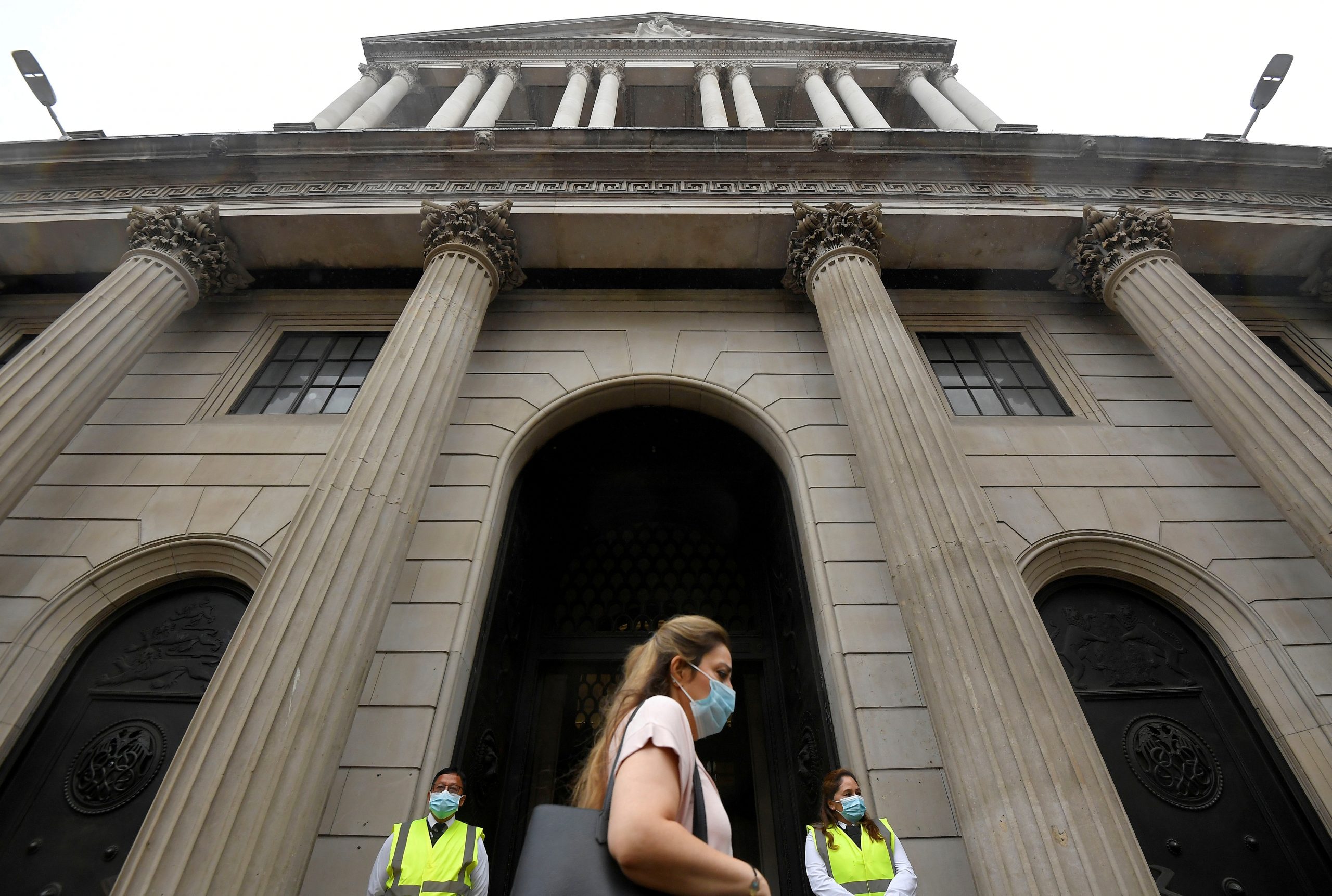The Bank of England’s decision on Thursday to slow the pace of its bond-buying makes it the second central bank from a G7 economy to begin the slow exit from pandemic-era money-printing stimulus schemes.
The big three of central banking – the U.S. Federal Reserve, European Central Bank and the Bank of Japan – won’t officially pare stimulus for a while.
Yet there are growing signs that policymakers have their eyes on the exit as vaccine rollouts pick up and growth bounces back. The Bank of Canada‘s C$1 billion ($806 million) cut to its weekly bond-buying programme last month highlights the next phase is about slowing hefty asset purchases.
Bank of America estimates central bank asset purchases in the United States, Japan, the euro zone and Britain will slide to about $3.4 trillion this year from almost $9 trillion in 2020. For 2022, it predicts purchases of just $400 billion.
Here’s a look at who is tapering, who may raise interest rates and who might be the last to call time on pandemic-era monetary stimulus.
1/ NORWAY
Norges Bank is at the vanguard in terms of signalling a retreat, and said on Thursday it is on track to hike interest rates in the second half of 2021.
That has made the crown this year’s best performing G10 currency. The central bank doesn’t intervene in bond markets, so the taper debate is not applicable.
2/ CANADA
Having announced tapering, Canada has signalled that its key interest rate could rise from 0.25% late in 2022.
3/ BRITAIN
Flagging a stronger economic rebound, the BoE will slow bond-buying to 3.4 billion pounds ($4.7 billion) a week, from the 4.4 billion-pound current weekly pace.
However, it kept the total size of the bond-buying programme unchanged at 895 billion pounds and Governor Andrew Bailey said the move did not amount to tapering.
“Since the Bank has already purchased 70 billion pounds out of the 150 billion pounds in gilts to be purchased by the end of 2021, purchases were already set to naturally slow,” Ambrose Crofton, global market strategist at JPMorgan Asset Management, said.
For a graphic on British bond markets stable as BoE slows weekly bond buys:
https://fingfx.thomsonreuters.com/gfx/mkt/jbyvryljzpe/GB0605.png
4/ UNITED STATES
The Fed plans to keep borrowing costs near 0% and maintain monthly asset purchases worth $120 billion until it sees “substantial further progress” towards full employment and its 2% flexible inflation target.
But with the economy expected to grow by more than 6% this year and inflation to be a “little higher” – according to Fed boss Jerome Powell – markets are pricing in a rate rise in 2023. Many analysts expect tapering to start this year.
The Fed faces a delicate balancing act, ensuring that tapering at a time of massive U.S. government borrowing does not boost Treasury yields too much.
Pictet Wealth senior economist Thomas Costerg expects tapering to start by early 2022 and proceed at a monthly pace of $10 billion. That process would last about a year – “enough to keep expectations for the first rate hike well in the distance”, he added.
For a graphic on Central bank holdings of government bonds:
https://fingfx.thomsonreuters.com/gfx/mkt/yxmvjdwyevr/CBANKS2704.PNG
5/ SWEDEN
Swedish inflation is approaching the Riksbank’s 2% target but it has said interest rates would stay at 0% for years. However, its 700 billion crowns ($84 billion) asset purchase programme will wind down this year as planned.
6/ EURO ZONE
Anaemic long-term inflationary pressures mean euro area rates are unlikely to rise for years. But tapering may come sooner, especially within the European Central Bank‘s 1.85 trillion euro ($2.2 trillion) pandemic emergency purchase programme (PEPP).
Technically, this runs until March 2022 but some officials are already advocating reducing bond purchases as growth rebounds.
Danske Bank analysts reckon the ECB will end up using only 1.65 trillion euros of the total PEPP stimulus package.
For a graphic on ECB weekly PEPP purchases:
https://fingfx.thomsonreuters.com/gfx/mkt/jznpnrbeopl/ECB0605.PNG
7/ AUSTRALIA
Australia’s economic rebound has surpassed expectations but the Reserve Bank of Australia, which has underscored its dovish credentials by adopting yield curve control, could be among the last to tighten policy.
It wants unemployment slashed and inflation within its 2% to 3% target before shifting tack, and doesn’t see either happening until 2024. Economists expect rates to stay on hold until then.
The RBA’s A$100 billion ($77.45 billion) QE programme ends in September and it will consider in July whether to extend it.
8/ NEW ZEALAND
New Zealand’s strong recovery and red-hot property markets have raised speculation a rate rise may come sooner than expected.
While its key interest rate is expected to stay at 0.25% this year, some analysts predict a rise in the second half of 2022. The central bank meanwhile appears to be in no hurry to taper its NZ$100 billion ($72 billion) QE programme.
9/ JAPAN
The BOJ pledged last week to maintain stimulus using yield target control and via bonds and equity purchases.
It has been accused of “stealth tapering” because its bond-buying has slowed since yield curve control (YCC) was adopted in 2016, though purchases have picked up slightly in the past year.
In March, they were about 22.2 trillion yen ($204 billion)above levels a year ago. But that’s still a quarter of the 81.96 trillion yen year-on-year increase in August 2016, just before YCC came in.
For a graphic on BOJ steadily ‘stealth’ tapering its JGB buying:
https://graphics.reuters.com/GLOBAL-CENTRALBANKS/TAPER/bdwpkbmllvm/chart.png
10/ SWITZERLAND
The Swiss National Bank does not intervene in domestic bond markets, instead capping the Swiss franc through interventions which came to nearly 110 billion francs ($120 billion) in 2020. The proceeds are used to purchase foreign bonds and equities.
The SNB shows no signs of departing from its interventionist policy; its chairman Thomas Jordan said last week that negative rates and a readiness to intervene in currency markets remain “essential”.
(Reporting by Sujata Rao, Tommy Wilkes, Saikat Chatterjee and Dhara Ranasinghe in London and Leika Kihara and Daniel Leussink in Tokyo; Editing by Toby Chopra)
Related
























